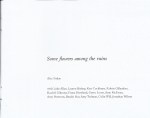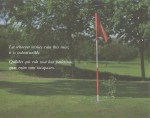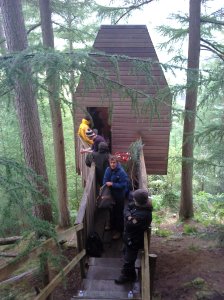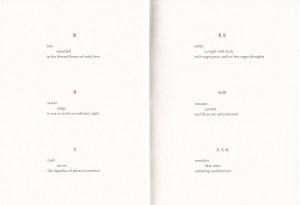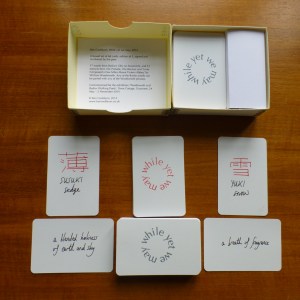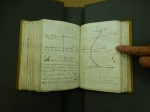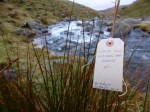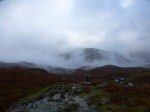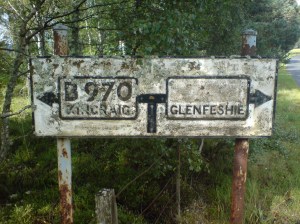T is for Triduana



In the 19th century, and into the 20th, the main industry in the Canongate was brewing. There were a lots of springs and streams, now channeled underground, providing a good supply of water. Walking into Holyrood Park you soon come across St Margaret’s Well, a spring which has long existed, but whose well-house, as the sign says, was installed here in 1860s, after being moved from Restalrig, about a mile to the east. It’s a miniature copy of St Triduana’s Aisle, a 15th century chapel badly damaged at the Scottish Reformation in 1560, but restored in the early 1900s. I was very struck by it when I first visited 20 years ago, and wrote a poem about it, ‘Intercession’. In the extract below, the first verse gives Triduana’s story; the second describes the well-house.
The unusual hexagonal chapel was built for James III
above a spring, and the floor-slabs, laid below ground level,
would have been underwater: became, much later,
linked with Triduana, an ‘obscure Pictish saint’,
who gifted a princely suitor enamoured of her eyes
those eyes on thorns; was granted her desired seclusion.
*
… Where a well-house stands,
the chapel’s miniature double,
exact down to the floral bosses,
but pumpless: mosses thrive,
and a pipe dribbles water
into a pool of water.
U is for University





Mesostic Interleaved was a project by Alec Finlay for the The University of Edinburgh Library when it was renovated in 2009. It features 100 mesostics by Alec, myself and other poets on the names of authors held in the library, which were was realised as a book, as a set of bookmarks, and as coloured shelf-ends within the library itself. The two shelf end mesostics pictured are:
rustiC gOds reloCated, craigcrooK’s Bucolic satUrdays inspiRe frieNdship
Man, gO Roam amonG An aNagram
The first is for Henry Cockburn (1779–1850) (no relation), whose friend Francis Jeffrey moved out of Edinburgh to then country district of Craigcrook; the second is for the poet Edwin Morgan (1920–2010), and nods towards Bob Cobbing’s extensive list of anagrams on EDWIN MORGAN, which begins:
AM WONDERING
NOW DREAMING
WORD MEANING
WANDERING ‘OM’
Alec also wrote a circle poem incorporating a mesostic, here shown in its printed form, which was installed as steel text in stone outside the entrance to the library. You can read his account of the project here.
V is for Vailima


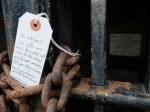
Robert Louis Stevenson (1850–94) bought the estate of Vailima in January 1890, having arrived in Samoa the previous month. He wrote the poem ‘The tropics vanish…’ about the same time. In it he imagines he is high on the Pentland Hills just south of Edinburgh, looking over on the city, before he zooms in on the family vault in the New Calton Burying Ground, where his grandfather and other relatives are buried. Many of them were engineers, and the family became known as ‘the Lighthouse Stevensons’, for all the lighthouses they built around the Scottish coasts. The poem was published posthumously in Songs of Travel (1895), a volume prepared by Stevenson before his death.
Far set in fields and woods, the town I see
Spring gallant from the shallows of her smoke,
Cragged, spired, and turreted, her virgin fort
Beflagged. About, on seaward-drooping hills,
New folds of city glitter…
There, on the sunny frontage of a hill,
Hard by the house of kings, repose the dead,
My dead, the ready and the strong of word.
Their works, the salt-encrusted, still survive;
The sea bombards their founded towers; the night
Thrills pierced with their strong lamps. The artificers,
One after one, here in this grated cell,
Where the rain erases, and the rust consumes,
Fell upon lasting silence…
There are photographs of RLS at Vailima at https://www.capitalcollections.org.uk (search for ‘Vailima’).
W is for Waverley






Walter Scott (1771–1832) published his first novel, Waverley; or, ‘Tis Sixty Years Since, in 1814. He was already famous for such poems as The Lay of the Last Minstrel (1805) and The Lady of the Lake (1810), but the novel was published anonymously, and Scott didn’t admit publicly to writing this and the many novels that followed until 1827. Waverley is set during the Jacobite Rebellion of 1745, and narrates the adventures of a young English nobleman who finds himself in Bonnie Prince Charlie’s army. But he’s never quite sure which side he wants to be on, hence his name. The railway station at the east end of Princes St which opened in 1846 was named after Scott’s work. In 2014, to celebrate the 200th annversary of the novel’s appearance, and the re-opening of the line between Edinburgh and the Scottish borders, quotations from Scott’s works were installed around the station by Edinburgh City of Literature.
X is for Charles X


In the past the area around Holyrood Palace was a debtor’s sanctuary. One man who took advantage of that sanctuary was Charles Bourbon, Comte d’Artois (1757–1836), the youngest brother of Louis XVI, guillotined after the French revolution. Charles left France and raised an army to fight the revolutionaries, which lost the first battle it fought. The now heavily indebted Charles fled to Britain; to protect him from his creditors the government sent him north to Holyrood, where he lived from 1796 to 1803. He later returned to mainland Europe, and to France itself after Napoleon’s defeat at Waterloo. In 1824 he became king, but his unpopularity led to his overthrow in 1830 and, given those still outstanding earlier debts, his return to Holyrood.
A year before his fall, he had met the young poet and playwright Victor Hugo (1802–85). Hugo’s play Marion de Lorme had been banned by the censor; his appeal against the ban surprisingly led to a private audience with Charles. But the ban remained, and some years later Hugo wrote a poem about their meeting, contrasting the sumptuous surroundings of Saint Cloud, the palace to the west of Paris where they met, with Charles’ residence at Holyrood, which had suffered from decades of neglect. Hugo never visited Scotland, so he wrote from imagination. He titled the poem ‘Le Sept Août 1829’ (‘7th August 1829’), which was the date of their meeting.
Holyrood ! Holyrood ! la ronce est sur tes dalles.
Le chevreau broute au bas de tes tours féodales.
Ô fureur des rivaux ardents à se chercher !
Amours ! — Darnley ! Rizzio ! quel néant est le vôtre !
Tous deux sont là, — l’un près de l’autre ; —
L’un est une ombre, et l’autre une tâche au plancher !
Holyrood! Holyrood! The bramble is on your flagstones. / The goat grazes beneath your feudal towers. / O fury of the ardent rivals who seek each other! / Loves! — Darnley! Rizzio! what void is yours! / Both are there, — one next to the other; — / One is a shadow, the other a stain on the floor!
cf A.J. Mackenzie-Stewart’s book A French King at Holyrood (1997).
Y is for Chiang Yee

Chiang Yee (1903–1977) was a Chinese poet, author, painter and calligrapher who lived in Britain from 1933–1955, then spent 20 years in the USA (at Colombia University) before returning to China shortly before he died. He wrote a series of books as The Silent Traveller, including The Silent Traveller in Edinburgh, written during the war years and published in 1948. In it he pairs his own translations of classic Chinese poems with places and people he encounters in the city. In the New Calton Burying Ground he sees the Burns monument, and writes:
When I looked up at it from the lower level of the New Calton Burying Ground it seemed to me singularly beautiful and serene… My thoughts on Burns went further… I began to wonder about his nationality… Recently I read ‘Shakespeare’s Legacy’ by the late Sir James Barrie in which the wife asserts to her husband that Shakespeare was a Scot from Glen Drumly, so why should I not claim Robert Burns as a Chinese by birth, particularly as I can quote the following poem from a collection of Chinese love-songs from twenty-five centuries ago?
Bonnie is my quiet lassie, supposed to be
Waiting for me at the corner of the city wall.
I love her but know not where she is.
Scratching my head I pace to and fro.
Fair is my quiet lassie,
Who gave me a crimson reed.
This crimson reed glows
And reflects her beauty that I love.
From the pasture she brought back for me a tender blade,
So beautiful and rare.
It is not that you, the blade, are beautiful,
But you are the gift of my love.
I do not wish to start an argument, nor to claim that I know anything about Christianity, yet it seems to me that Robert Burns’ life and thoughts are more Confucian than Christian.
Z is for riZZio


David Rizzio (to use the more common spelling, though the plaque in the Canongate kirkyard opts for Riccio), came to Scotland from his native Turin in 1561. A good musician, and a Catholic, he found favour with Mary Queen of Scots, lately returned from France. In 1565 Mary married a Protestant noble, Lord Darnley, who soon became jealous of Rizzio. On 9 March 1566 Darnley and other Protestant lords burst into her chamber at Holyrood Palace and murdered Rizzio in front of her. Within a year Darnley too was dead, and the country descended into civil war; Mary was forced to abdicate and fled to England. In Hogg’s The Queen’s Wake (1813), Rizzio is the first poet to recite his work to the court.
Short was the pause ; the stranger youth,
The gaudy minstrel of the south,
Whose glossy eye and lady form
Had never braved the northern storm
Stepped lightly forth, — kneeled three times low, —
And then, with many a smile and bow,
Mounted the form amid the ring,
And rung his harp’s responsive string.
Though true the chords, and mellow-toned,
Long, long he twisted, long he coned ;
Well pleased to hear his name they knew ;
‘Tis Rizzio!’ round in whispers flew.
And the beginning of that performance seems as good a place as any to end.





























